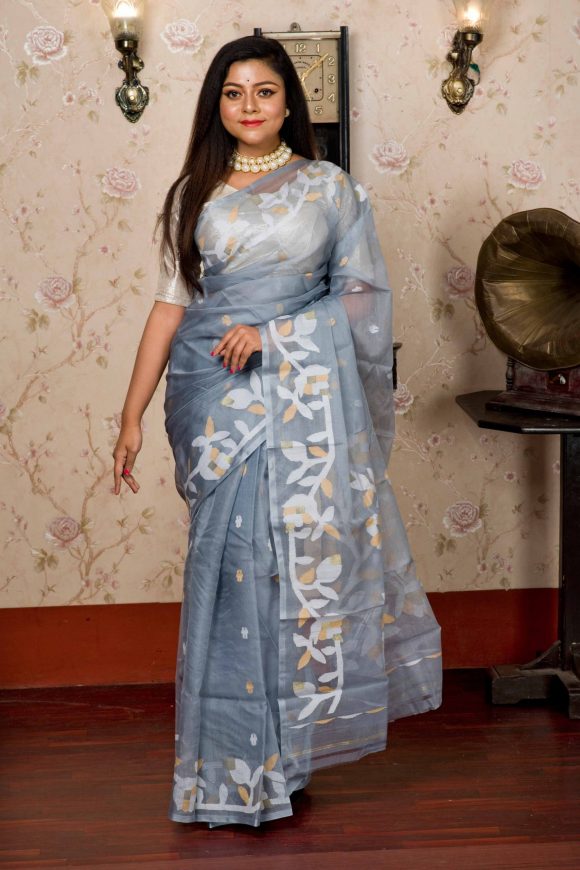Muslin
Muslin Sarees: A Drapery with an Exotic History
Muslin sarees are surely one of the most exotic draperies you will come across in the Indian subcontinent. History, evolution, comfort, and fashion! All these elements are weaved through gorgeous Muslin sarees that women have been craving for ages. The almost transparent texture and the subtle sheen made Muslin sarees a celebration of feminine sensuality and poise.
Be it the traditional red and white Muslin sarees or some other variations, Muslin sarees never cease to impress. They are also comfortable and convenient to drape. So, even busy women of today find them suitable for various occasions. They go well with golden or pearl jewelry and subtle makeup.
Muslin Sarees: Rooted Deep in History:
It is said that the Muslin fabric got its name from Mosul, a city in Iraq. However, it will be more just to suggest that Muslin has always been an indigenous specialty of the Indian subcontinent. It was earlier known as Jamdani, and historical evidence proves that Muslin was originally born in this part of the world. So, wouldn’t it be nice to enhance your ethnic collection with a Muslin saree that makes you proud of your country’s richness in textiles and artistry?
Nevertheless, coming back to the history of Muslin fabric, you will find its mention in Chanakya’s Arthashastra. Even many travelers from Greece, England, and Egypt have mentioned this exotic fabric with respect in their memoirs. The primary fame and glory of the fabric were spread because of its abundant use in sarees which were popular among women from various walks of life.
As the fabric started gaining more and more popularity, the Muslin industry experienced a boom by exporting sarees and fabrics to various parts of Europe. English, Portuguese and Dutch traders invested in this industry, and they even started selling Muslin sarees or fabric to China, the Middle East, and other parts of the world.
However, British colonization during the 18th century almost ruined this industry. The British traders and rulers wanted to have a monopoly over this business, and in an attempt to maximize their profit, they deprived the weavers and artisans associated with it. Today, Indian and Bangladeshi governments and many non-profit organizations are trying to revive this rich heritage.
Muslin Sarees Evolving for Modern Day Fashionistas:
The threads for making Muslin fabrics are specially procured from cotton plants grown in very specific parts of Bengal and Bangladesh. The threads need to be weaved in a very complex and intricate pattern to make a beautiful Muslin saree. Muslin sarees, as well as the fabric, may differ in terms of finesse and prices as there are definite categorizations in types of Muslin fabrics.
The finest variety is known as the Mulmul Khas, and the second-best category is Abrawan, which is said to have finesse and transparency like running water. Shabnam, Circar Ali and Tungzeb are some of the other finest Muslin fabric to be made. However, unfortunately, the finest quality Muslin sarees with very high thread counts are a thing of the past today. The best you can find today cannot match even half the thread count when compared to the Muslin sarees of early days.
Nevertheless, there has been an earnest attempt to revive this Muslin industry. To keep up with the latest fashion trends, the weavers are introducing geometrical, self, and buti works in the sarees along with the conventional floral designs.
Muslin Sarees at Ashmi’s Creations:
In our Muslin sarees collection at Ashmi’s Creations, we have tried to assemble sarees that are the right fusion of tradition and trend. They are available in monochromes, subtle pastel shades, and many other colors. You just need to explore them to make your favorite pick.
With us, you will get the best quality Muslin sarees at the most reasonable price. Besides, we offer a free shipping facility across West Bengal, and our payment procedure is 100% secure. So, hurry up and give your wardrobe a fresh new lease of life with Muslin sarees.





